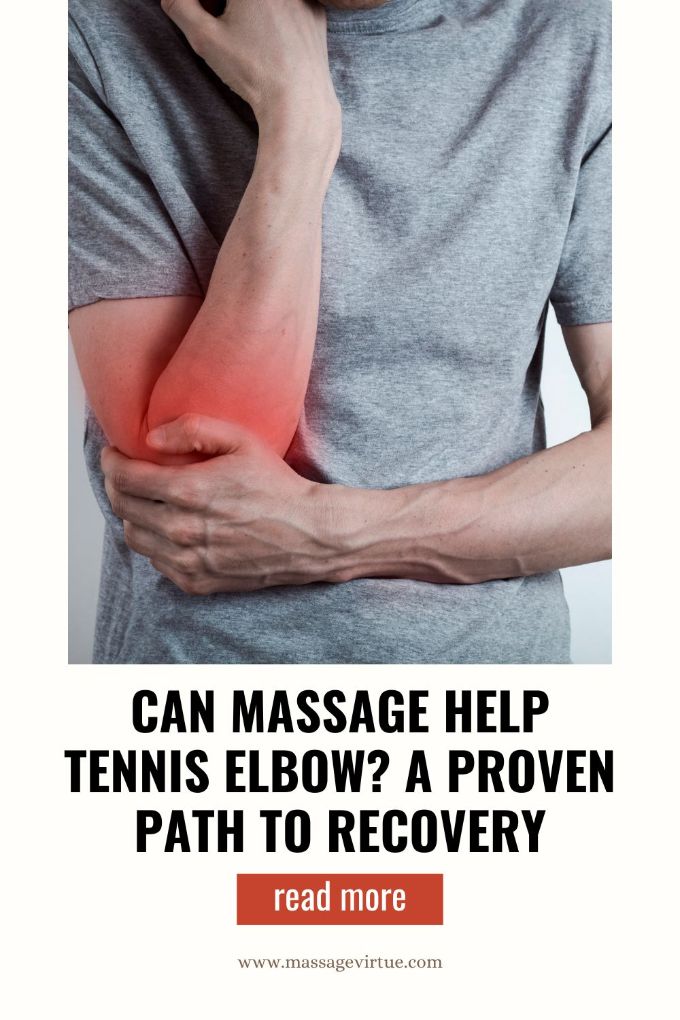If you’ve ever experienced the nagging pain, stiffness, and weakness associated with tennis elbow, you know how debilitating it can be.
Whether you’re an athlete, musician, or someone dealing with repetitive strain injuries, the discomfort of lateral epicondylitis, commonly known as tennis elbow, can significantly impact your daily life.
In this article, we’ll explore the potential benefits of massage therapy in managing and alleviating tennis elbow symptoms.
Can Massage Help Tennis Elbow?
Yes, massage can be beneficial for tennis elbow. It can help reduce pain, inflammation, and muscle tension associated with this condition.
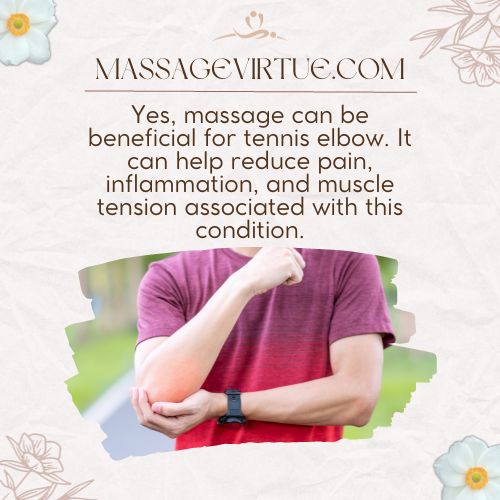
Specific massage techniques, like deep tissue and trigger point therapy, can target affected areas, providing relief and promoting healing. However, it’s essential to consult with a healthcare professional or licensed therapist.
They will give guidance on the most suitable approach based on your individual case.
Massage and Tennis Elbow: How Does It Help?
Massage therapy has gained recognition as a non-invasive and holistic approach to managing pain and inflammation in various musculoskeletal conditions, including tennis elbow.
Let’s explore how massage can aid in providing much-needed relief and promoting healing for this troublesome condition.
1. Pain Reduction
One of the most immediate benefits of massage for tennis elbow is pain reduction.
Skilled massage therapists can target the affected forearm muscles and tendons, using various techniques to release tension and alleviate discomfort.
Deep tissue massage, for instance, can help break down knots and trigger points, which are often a source of pain and inflammation.
2. Improved Blood Circulation
Massage stimulates blood flow to the injured area, which is essential for the healing process.
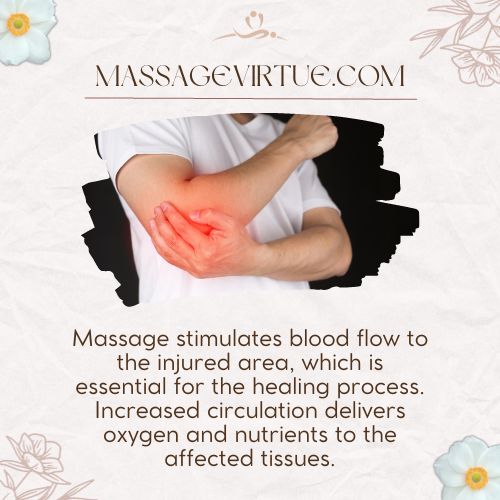
Increased circulation delivers oxygen and nutrients to the affected tissues, aiding in their repair and reducing inflammation.
By promoting better blood flow, massage can accelerate the recovery time for tennis elbow.
3. Muscle Relaxation
Tight and tense forearm muscles are common in individuals with tennis elbow.
Massage techniques like effleurage and kneading can help relax these muscles, reducing stiffness and enhancing flexibility.
Relaxed muscles are less prone to further injury, making massage a valuable part of the rehabilitation process.
4. Release of Trigger Points
Trigger points, or localized knots within muscles, can exacerbate the pain and stiffness associated with tennis elbow. Skilled massage therapists can identify and target these trigger points, applying pressure to release them.
This not only provides immediate relief but also prevents them from causing ongoing discomfort.
5. Enhanced Range of Motion
Tennis elbow can limit your ability to move your arm freely. Regular massage sessions can gradually improve your range of motion by reducing muscle tension and stiffness.
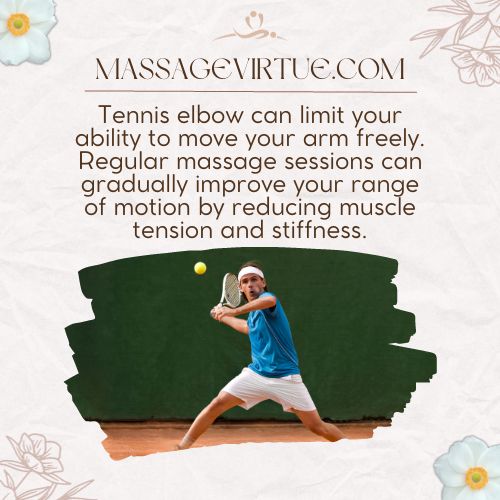
This can be particularly beneficial for athletes and musicians who rely on precise and fluid movements.
How to Massage Tennis Elbow? A Step-by-step Guide
Massaging tennis elbow can be an effective way to alleviate pain and promote healing. Here’s a step-by-step guide on how to massage your tennis elbow:
Before You Begin
Before attempting self-massage for tennis elbow, it’s essential to ensure that you’ve consulted with a healthcare professional or a licensed massage therapist.
Additionally, make sure your hands are clean, and you have a comfortable, quiet space to perform the massage.
Step 1: Warm-Up
Begin by gently warming up the muscles in the affected arm to increase blood flow and relax the tissues. You can do this by:
- Apply a warm compress or heating pad to the affected area for 10-15 minutes.
- Alternatively, you can take a warm shower or bath to relax the muscles.
Step 2: Self-Massage Techniques
There are several massage techniques you can use to target tennis elbow pain:
a. Effleurage
Effleurage involves gentle, long strokes along the forearm and elbow. Use your fingers, thumb, or the palm of your hand to apply light pressure while moving towards your wrist.
Repeat this motion for 5-10 minutes to warm up the tissues further.
b. Circular Friction
After effleurage, use your thumb or fingertips to apply circular friction to the tender areas around your lateral epicondyle (the bony bump on the outer part of your elbow).
Apply moderate pressure while making small circular motions. Focus on any knots or trigger points you may feel.
c. Cross-Fiber Friction
To target specific areas of pain and stiffness, use cross-fiber friction. Place your thumb or fingertips perpendicular to the direction of the muscle fibers and apply deep, short strokes.
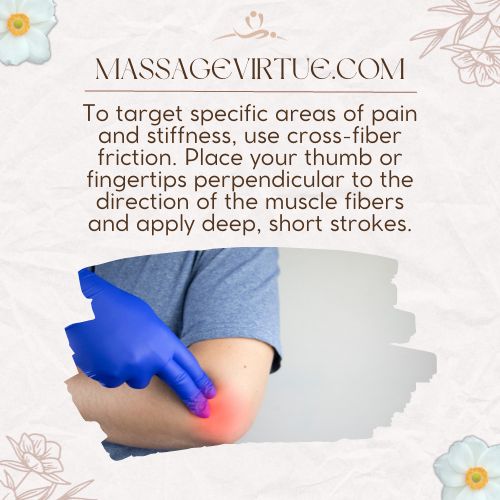
This technique helps break down scar tissue and adhesions in the affected tendons.
d. Stretch and Hold
Gently stretch the forearm muscles by extending your arm straight and flexing your wrist so your palm faces up.
Use your opposite hand to hold your fingers or wrist in this position, maintaining a mild stretch for 20-30 seconds. This helps relieve tension in the muscles.
e. Trigger Point Release
If you identify trigger points (tight knots), apply focused pressure to these areas. Use your thumb or fingertips to press firmly on the trigger point and hold for 20-30 seconds.
Gradually release the pressure as the muscle relaxes.
Step 3: Gradual Progression
During the massage, pay attention to your body’s response. You should feel some relief as the muscles relax.
However, be cautious not to overdo it. If you experience increased pain or discomfort, stop the massage and consult your healthcare provider.
Step 4: Cool Down
After the massage, apply a cold pack or ice wrapped in a cloth to the treated area for about 15-20 minutes. This helps reduce any potential inflammation or soreness caused by the massage.
Step 5: Rest and Repeat
Give your arm some rest after the massage. It’s essential to repeat these self-massage techniques regularly, preferably 2-3 times a day, to experience cumulative benefits.
Consistency is key to managing tennis elbow effectively.
Conclusion
In a nutshell, massage therapy offers a promising avenue for those seeking relief from the pain, inflammation, and limitations caused by tennis elbow.
By addressing the root causes of the condition and promoting both physical and psychological well-being, massage can be an invaluable addition to your treatment plan.
Remember to consult with a qualified massage therapist and work closely with your healthcare provider to ensure the best possible outcome.
FAQs
What Is the Best Massage for Tennis Elbow?
The best massage technique for tennis elbow is deep tissue massage.
This therapy targets trigger points and knots in the affected forearm muscles, helping to alleviate pain, reduce inflammation, and promote healing.
What Pressure Point Relieves Tennis Elbow?
The pressure point that can provide relief for the tennis elbow is often found near the lateral epicondyle (outer part of the elbow).
Applying firm but controlled pressure to this area with your thumb or fingertips can help release tension and reduce pain.
